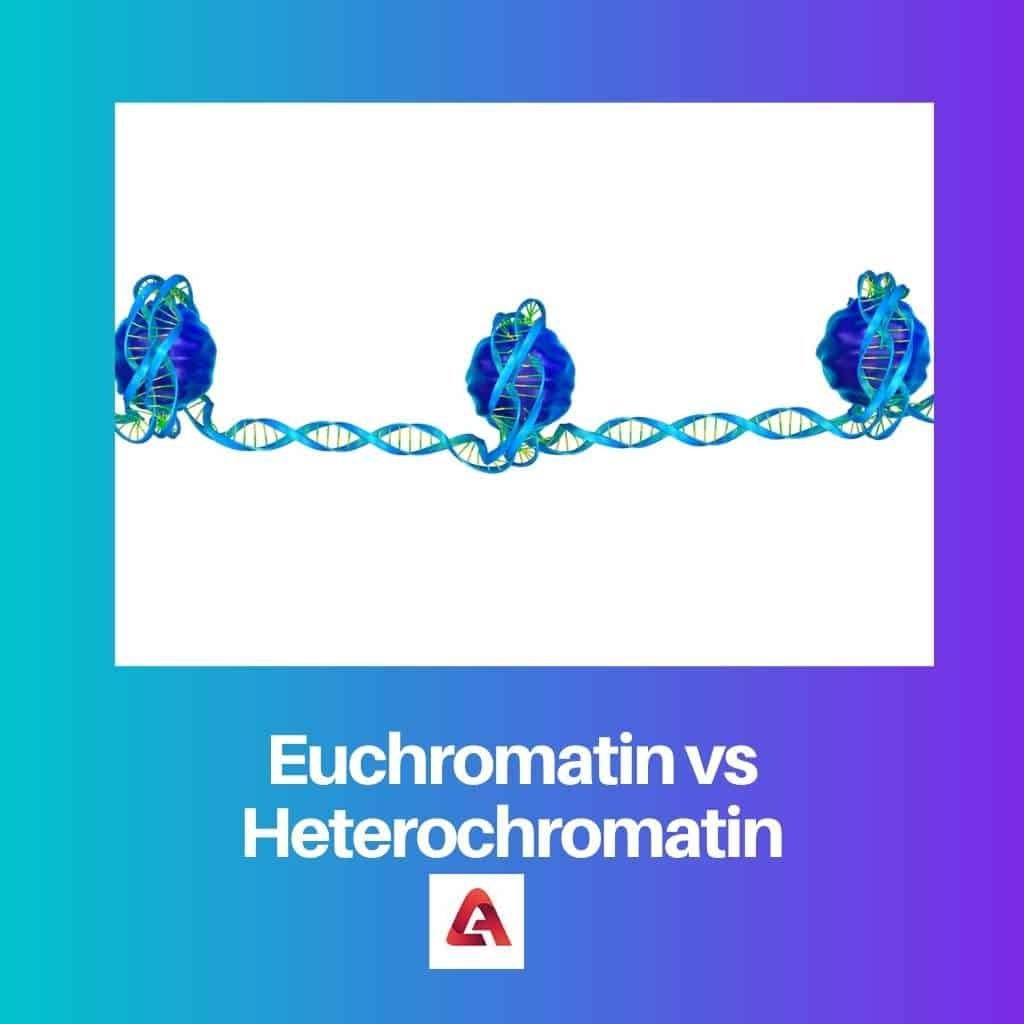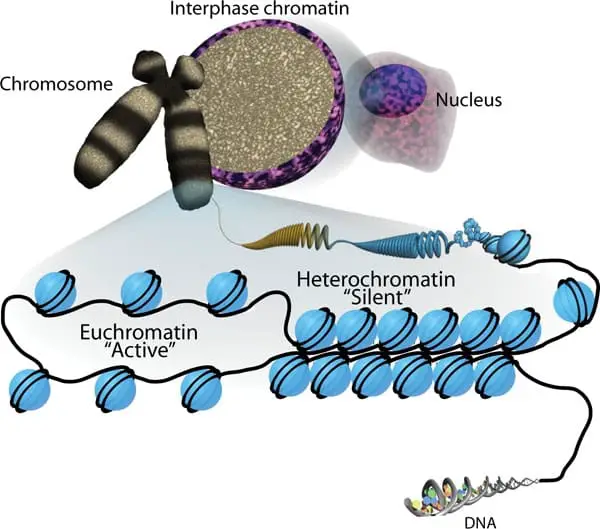Our bodies are made up of trillions of cells. A nucleus is found in every cell, and the nucleus encompasses chromatin.
The ontology of chromatin, as per microbiologists, is the DNA, proteins, and RNA complex recovered from the eukaryotic lysed interphase nucleus.
To put it plainly, chromatin is a mixture of deoxyribonucleic acid (DNA) and various forms of proteins. This article also aids in distinguishing between the two forms of chromatin, namely Euchromatin as well as Heterochromatin.
Key Takeaways
- Euchromatin is less condensed, transcriptionally active DNA, while heterochromatin is more condensed and transcriptionally inactive.
- Euchromatin comprises gene-rich regions of the genome, whereas heterochromatin contains repetitive sequences and few genes.
- Euchromatin is crucial in gene expression regulation, while heterochromatin maintains genomic stability.
Euchromatin vs Heterochromatin
Euchromatin is the less condensed and more active form of chromatin involved in gene expression. Heterochromatin is the more condensed and less active form of chromatin that is not involved in gene expression and contains genes that are not actively transcribed or used by the cell.

Under a microscopic examination, the inactive cells of the nucleus are divided into two zones measured by the concentration or strength of staining.
Following the inspection, the darkly stained zone discovered under the light microscope is referred to as heterochromatin, whereas the faintly stained portion is referred to as euchromatin.
The appearance of euchromatin indicates that cells are active in gene transcription, i.e. constantly translating DNA to mRNA.
Euchromatin is located in the nucleus of all eukaryotes as well as accounts for even more than 90% of the genetic code. In contrast to heterochromatin, which is closely packed, euchromatin is a kind of chromatin that is loosely packed.
Heterochromatin, on the other hand, is a densely packed type of DNA, also known as compressed DNA, that appears in a variety of forms.
These variants fall on a spectrum spanning constitutive heterochromatin as well as transcriptional heterochromatin. Both have a function in gene regulation.
Comparison Table
| Parameters of Comparison | Euchromatin | Heterochromatin |
|---|---|---|
| Definition | Euchromatin is a kind of genetically active chromatin material that is loosely packed (DNA, RNA, and protein) and is abundant in genes. | Heterochromatin is a densely packed type of DNA located in the nucleus. These are so densely packed that the protein associated with gene transcription cannot access them |
| Texture | Regions of euchromatin are non-sticky in nature and texture. | Regions are sticky textured in a heterochromatin. |
| Heteropycnosis | No heteropycnosis is visible in euchromatin | Heteropycnosis is visible in heterochromatin. |
| Found In | Both eukaryotic as well as prokaryotic cells. | Only and specifically found in eukaryotes and eukaryotic cells. |
| Color in Stain | Euchromatin appears lightly colored when stained under a light or optical microscope. | Heterochromatin appears dark in color when stained and viewed under a light microscope. |
What is Euchromatin?
Euchromatin is a genetically active chromatin material that is loosely packed (DNA, RNA, and protein) and is abundant in genes. It is frequently (sometimes not) under active translation.
In comparison to heterochromatin, which is tightly populated and less permeable for transcribing, euchromatin is more open. The genetic code in euchromatin is 92 percent of its parts.
Even though it is loosely filled in the form of RNA, DNA, and protein, it is dense in gene density and frequently under active transcribing. If you look at prokaryotic and eukaryotic cells, you will see the existence of euchromatin.
Euchromatin is by far the most active part of the chromosome inside the cell nucleus in eukaryotic organisms.
Euchromatin is the sole kind of chromatin seen in prokaryotes, implying that its heterochromatin architecture arose later, including the nucleus, presumably as a strategy to deal with rising genomic sequences.
Euchromatin has the following characteristics:
- Euchromatin is found more towards the nucleus’s core and accounts for roughly 90% of an organism’s genetically active material.
- After stain application, it shows as light-colored bars under a light or an optical microscope. Heteropycnosis does not occur because all regions of euchromatin are evenly colored.
- Nevertheless, underneath an electron microscope, it looks like something of an elongated 10 nm microfilament.
- The pattern of euchromatin may be seen as an unfurled string of pearls, with the ‘pearls’ representing nucleosomes.

What is Heterochromatin?
Heterochromatin is a densely packed type of DNA located in the nucleus. These are so densely packed that the protein associated with gene transcription cannot access them.
Because of the aforementioned reasons, performing the chromosomal crossover becomes challenging. As a result, heterochromatin is both transcriptionally and genetically inert.
There are two kinds of heterochromatin structure: facultative heterochromatin as well as constitutive heterochromatin.
- Facultative Heterochromatin: The genes that become inactive by the process of Protein methylation and sometimes even called as siRNA via RNAi are referred to as facultative heterochromatin. As a result, they are made up of dormant genes and are not believed to be a permanent part of each cell’s nucleus.
- Constitutive Heterochromatin: Constitutive heterochromatin is made up of repeating highly structurally relevant genes such as telomeres as well as consists of three processes. The architecture of constitutive heterochromatin can be retained even during the cell’s metaphase. They have no genes in their genome. These are also referred to as the permanent nature of the nucleus of the cell.

Main Differences Between Euchromatin and Heterochromatin
- Euchromatin is a lightly packed and less constricted DNA, whereas heterochromatin is tightly packed DNA.
- Euchromatin, when stained, appears light in color under a light microscope, whereas heterochromatin appears dark in color.
- Euchromatin does not show heterozygosity, whereas heterochromatin shows heterozygosis.
- Euchromatin is found in both prokaryotes and eukaryotes, whereas heterochromatin is only found in heterochromatin.
- Euchromatin is present in the inner side of the nucleus, whereas heterochromatin is present on the periphery of the nucleus.
- https://www.ncbi.nlm.nih.gov/pmc/articles/PMC6822695/
- https://www.sciencedirect.com/topics/biochemistry-genetics-and-molecular-biology/euchromatin

This article is great for anyone seeking to understand the underlying differences between euchromatin and heterochromatin. Its detailed comparison table is excellent.
It’s remarkable how this article provides such thorough details on the differences between euchromatin and heterochromatin. It’s a great source of knowledge.
An excellent article with comprehensive information about chromatin explained in a clear manner.
The way gene expression regulation and genomic stability are differentiated between euchromatin and heterochromatin is truly enlightening. Well done!
The structural and functional differences between euchromatin and heterochromatin are precisely and explicitly explained. Brilliant piece of work!
I’m surprised to find such detailed information on euchromatin and heterochromatin. A well-researched and educational read.